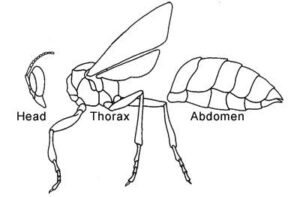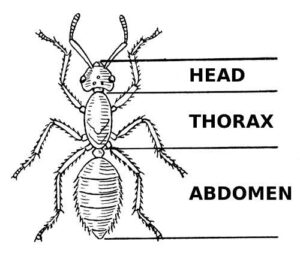Back to: ZOOLOGY 200 Level
WELCOME TO CLASS
Today, we’ll be exploring the anatomy of some of the most fascinating creatures—arthropods. Specifically, we’re going to study their head, thorax, and abdomen. These three body regions are key to understanding how these animals function, move, and survive. Let’s break it down in a way that makes it all come to life!
Head, Thorax, Abdomen
The head: sensory and feeding functions
The head is the front-most part of many animals, and in arthropods, it’s packed with important features. The head houses sensory organs like antennae, which help the animal sense its environment, and compound eyes, which give it a wide field of vision. The mouthparts on the head are specially adapted for feeding, depending on what the creature eats. For example, a mosquito has piercing mouthparts to suck blood, while a grasshopper has chewing mouthparts to eat plants.

In some arthropods, like spiders, the head also contains fangs or venom glands, which they use for hunting or defence. The head is the control centre for gathering sensory information and feeding, making it crucial for survival.
The thorax: movement and wings
Just behind the head is the thorax, which is primarily responsible for movement. The thorax is where the legs and, in some species, wings are attached. For example, in insects like flies and beetles, the thorax holds three pairs of legs, each adapted for different types of movement, such as walking, jumping, or swimming.
In flying insects, the thorax contains two pairs of wings, which allow them to take flight. The structure of the thorax and how it is adapted for movement varies greatly between species, depending on their lifestyle. In some arthropods, like grasshoppers, the thorax is built to support strong, muscular legs for jumping, while in dragonflies, it is designed to support wings for agile flight.
The abdomen: digestion and reproduction
The abdomen is the posterior part of the body, where digestion and reproduction occur. It contains the digestive system, including the stomach and intestines, which are responsible for processing food. In addition to digestive organs, the abdomen houses the reproductive organs. Female insects, for example, carry eggs in their abdomen, while males have specialized structures for mating.

The abdomen also often has other important structures, such as spiracles for respiration or sting organs (in some species, like bees), which they use for defence. In some arthropods, the abdomen is segmented, with each segment serving a specific function, such as protecting vital organs or assisting with movement.
Summary
- The head houses sensory organs and mouthparts for feeding.
- The thorax is responsible for movement, with legs and wings attached.
- The abdomen contains the digestive and reproductive systems and other specialised organs.
- The structure of these body parts varies between species depending on their ecological roles and needs.
Evaluation
- What is the function of the head in arthropods?
- Describe the role of the thorax in arthropod movement.
- What functions occur in the abdomen of arthropods?
- How does the structure of the thorax differ in flying insects compared to those that cannot fly?
Well done for mastering the fundamental body structure of arthropods. Remember, every part of an animal’s body is finely tuned for its survival in the world around it. Keep up the great work, and let’s get ready for the next lesson on this fascinating journey!
